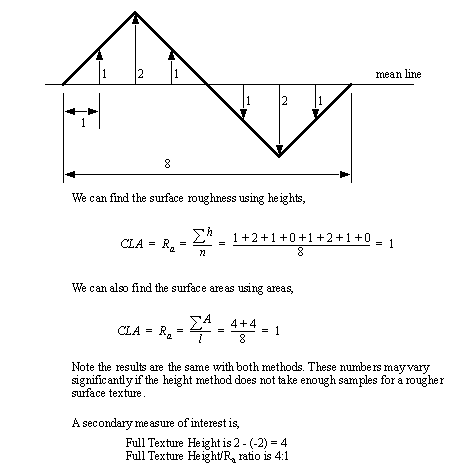
• No surface is perfectly smooth, but the better the surface quality, the longer a product generally lasts, and the better is performs.
• Surface texture can be difficult to analyze quantitatively. Two surfaces may be entirely different, yet still provide the same CLA (Ra) value.
• Recent developments in production technique, and metrology equipment have made it possible to specify and measure surface quality.
• There are standards, such as the CSA B95 1962.
• Surface Quality can be important when dealing with,
- lubrication - small indentations can hold lubricant
- resistant to wear - smoother surfaces wear less
- tool life - rough surfaces will correlate to shorter tool life
- corrosion - smoother surfaces easier to clean, less surface area to erode
- noise reduction - smooth surfaces make less noise when rubbing, for example meshing gears.
- fit - pressure seals could leak through pits
• Surface geometry can be quantified a few different ways.

• Real surfaces are rarely so flat, or smooth, but most commonly a combination of the two.

• Some other terms of interest in surface measurement,
- Surface texture - all of the details that make up a surface, including roughness, waviness, scratches, etc.
- Lay - the direction of the roughness on a newly manufactured surface. The roughest profile will be perpendicular to the lay.
- Flaws - small scratches, cracks, inclusions, etc.
- Cutoff - a value selected to be less than the waviness, but greater than the roughness length. This is controlled using electrical or digital filters. Typical values might be; 0.010”, 0.030”, 0.100”
• A simple measure of roughness is the average area per unit length that is off the centre line (mean). We will call this the Centre Line Average (CLA), or Arithmetic Average (Ra), the units are μinches.
• To calculate the roughness using samples at evenly spaced positions,

• The roughness can also be calculated by area,

• In both cases the mean line is located so the sum of areas above the line is equal to the sum of areas bellow the line.
• As an example we can examine a surface that has a triangular profile,

• One of the instruments that we will use is the Surfcom. If we were to have obtained the graph above from this device, we would have to use the following formula to determine the true values,
